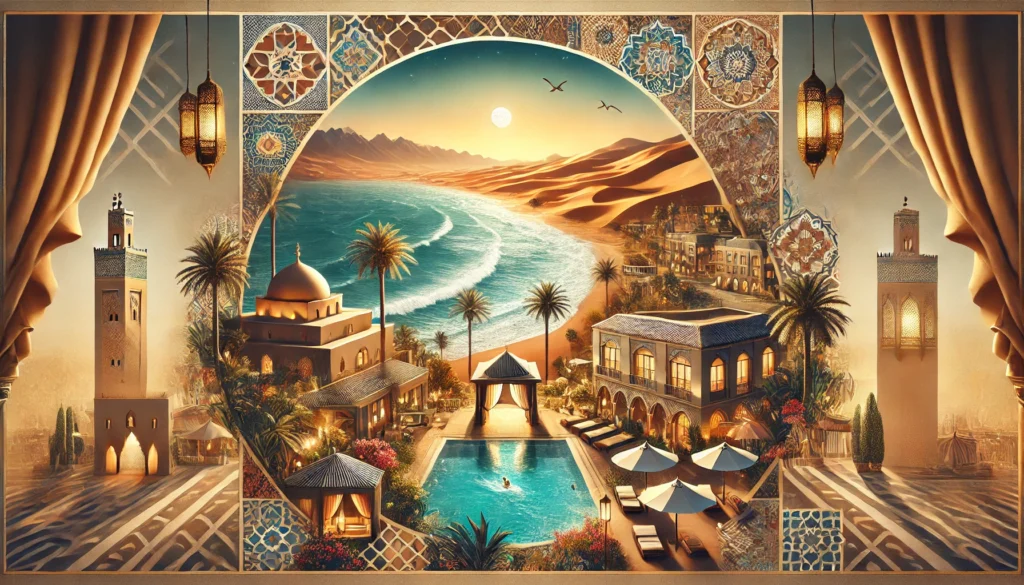Morocco earned its reputation as a top host because locals embrace guests with heartfelt service and-cultural custom. The Moroccan dining table and salon lights work together to showcase a heritage of inviting guests to experiences they will never forget. This research analyzes Moroccan hospitality practices to show how they differ from Arab traditional customs.
Moroccan Hospitality: A Tradition of Warm Welcomes
Morocco residents serve hospitality as their lifestyle. The moment you arrive hosts greet you with smiles and friendly words that say “Marhaba” which means “Welcome”. Moroccan people start unforgettable connections by sharing tea with guests since making tea acts as their traditional warm welcome practice.
The Role of Mint Tea in Moroccan Welcomes
In Moroccan culture mint tea functions as “Moroccan whiskey” when guests arrive. Mint tea prepared with new mint leaves becomes a sign of respect during welcoming guests. Each tea-pouring ritual represents how seriously the host approaches guest comfort. The high, elegant pour, creating a frothy layer at the top, adds a touch of artistryIt creates instant pleasure for guests while starting their Moroccan journey from the moment they enter.
Welcome guests that show Moroccan traditional values
In Moroccan culture hospitality shows how people respect their guests and create bonds. Welcoming guests into your home serves as a sign that they embrace family status during their visit. Moroccan people welcome guests with genuine warmth because they believe in practicing hospitality all day as the land of Morocco creates a welcoming environment.
Moroccan Cuisine: The Food Experience Touches Both Your Feelings and Senses
Moroccans welcome guests at mealtimes by serving them many tasty culinary options.. The meal, often shared in the family’s main gathering area, is a time of joy, connection, and storytelling. The traditional Moroccan menu is a tantalizing blend of spices, textures, and colors that offers a journey through the flavors of the Mediterranean, Berber, and Arabic influences.
Special Moroccan Foods That Show True Moroccan Hostiness
Moroccan hosts prepare their dishes to show how much they care for their guests. Traditional Friday family dinners feature couscous as one of its beloved dishes. Cookware known as tagine produces delicious slow-cooked stew items with spices and meat that please guests with their taste sensations.. People in Morocco prepare harira soup and bake fresh bread for meals during Ramadan because they continue traditions that give their food moments special warmth and friendliness.
Food Creates a Uniting Moment between People
Moroccan dining happens as a group activity when everyone sits together to enjoy one large plate.Guests are encouraged to eat with their hands, A simple slice of bread works as a unique tool to collect delicious portions while sharing meals. The personal way people eat with their hands at mealtime forms instant connections between diner’s while expressing Morocco’s powerful love of camaraderie.
The Traditional Moroccan Salon: Elegance and Comfort Combined
Moroccan hospitality starts with the salon or guest sitting room. Guests enter a magical room that offers padded seats at comfortable heights under beautiful lighting along side beautiful decorations. Moroccan artists craft this space to host visitors in both elegance and comfort which creates an ideal setting for talking and unwinding.
The Art of Moroccan Salon Decor
Moroccan salons are meticulously adorned with handmade rugs, colorful textiles, and ornate ceramic tiles. Richly designed cushions and couches are arranged to invite guests to unwind. At the same time, delicate lamps cast a warm, soothing glow over the room. You can see traditional Moroccan skills shining through the salon because designers want you to relax with them.
The traditional Moroccan salon shows Moroccan craftwork excellence and serves as a space designed for genuine comfort during visits.
At the salon people find Norwegian welcome and enjoy social moments with those they care about. Guests may spend hours here sipping tea and sharing stories, as the salon serves as a sanctuary where Moroccan generosity and warmth are expressed through time, comfort, and companionship.
Moroccan Hospitality Compared to Other Arab Cultures
While hospitality is a typical value across Arab cultures, Morocco’s approach has distinct qualities influenced by Berber and Arab traditions. Moroccan hosts greet visitors with special traditions so they feel accepted equally throughout urban areas and rural areas.
Moroccan vs. Arab Hospitality: Celebrating Unique Traditions
Morocco shows its warm welcome through multiple entertaining options. From the intricate tea ceremonies to the communal dining customs, Morocco weaves elements of its rich cultural tapestry into every part of the guest experience. Unlike many other Arab cultures, Morocco has an added layer of Berber influence, seen in the unique decor, traditional dress, and even the language used in welcoming visitors. The blend of Moroccan heritage generates a hotel experience that remains distinctly Moroccan.
Conclusion
Moroccan hospitality combines age-long traditions with stylish elegance to make cultural experiences you will never forget. All details at the Moroccan table from welcome to decor show how Moroccans live sharing and helping others. Visitors to Morocco both first time and repeated walk away with memories of genuine Moroccan culture that remains forever in their hearts.
External Sources for Further Reading
- Visit Morocco: Official Tourism Site of Morocco
- Moroccan National Tourist Office: Learn more about Morocco’s rich traditions
- The Art of Moroccan Cuisine: A guide to Moroccan culinary traditions


